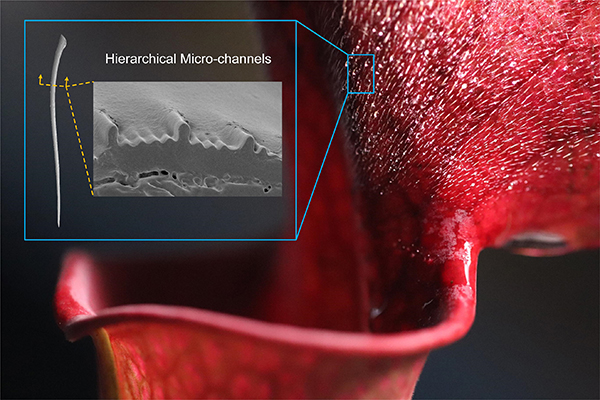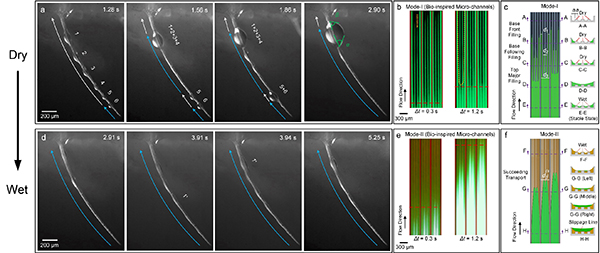

Under the support of the National Science Fund for Distinguished Young Scholars (51725501) and Key Project (21431009), the research group led by Prof. Chen Huawei of Beihang University have made an important progress in the research of dynamic mechanism on the bioinspired hierarchical surface. A novel ultrafast water transport phenomenon was discovered on the surface of Sarracenia trichome, which mainly attributes to its unique hierarchical microchannels. With cooperation with Academician Jiang Lei, this finding was published in Nature Materials in September 24, 2018 as “Ultrafast water harvesting and transport in hierarchical microchannels”. The article link is https://www.nature.com/articles/s41563-018-0171-9.
The high-speed liquid transport is gradually becoming a hot topic because of its diverse potential applications in mechanical engineering, electronics and even new energy fields. As one typical insect-trapping plant, Sarracenia is well known for its superior wet-slippery characteristic and attracts attention of research group. Through SEM observation of the trichomes, one unique hierarchical microchannel structure was found on the trichome surface, in which two types of ribs with different height regularly distribute around the trichome cone. These high and low ribs from hierarchical microchannels, where the larger channels are formed by two neighboring high ribs, and about 3~5 low ribs emerge inside the larger channel to form the smaller base channels (Figure 1).In the duration of water harvesting, two distinct modes of water transport appear in turn, i.e. formation of water thin film (Mode-I) and subsequent ultrafast water sliding on the water thin film (Mode-II). On the dry surface of trichome, the water transport is governed by normal capillary force. The transport of harvested waterdroplets on the dry trichome are similar with the cactus spine and spider silk by movement of intact whole water droplet along the trichome cone, defined as Mode-I(see Figure). In Mode-I, gradient structure of hierarchical microchannels results in appearance of gradient water transport velocity, and a stable thin film is formedand strongly kept on the surface of trichome with progress of water harvesting on dry trichome. Interestingly, liquid-solid contact will be greatly declined after water thin film formation in Mode-I, and the subsequent harvested water will slide on the water thin film. The subsequent water transport will speed up, and water transport mode also changes fromwater droplet movement to continuous liquid sliding on thin film, which is defined as Mode-II. Apart from mode change, the advancing meniscus shape of water transport also changes from concave in Mode-I to convex in Mode-II (see Figure).
This novel ultrafast water transport mechanism was experimentally and theoretically investigated in bio-inspired microchannels fabricated by lithography technology. The effects of these structure characteristics on the capability of ultrafast water transport were demonstrated, and a design principle was also proposed for ultrafast transport hierarchical microchannels. This finding can find diverse potential applications in heat radiator, microfluidic chip, water collector and sea water desalinization.
Source from Department of Engineering and Materials Sciences Yinan LAI, Xin YE

Add: 83 Shuangqing Rd., Haidian District, Beijing, China
Postcode: 100085
Tel: 86-10-62327001
Fax: 86-10-62327004
E-mail: bic@clinicaltrials-nyph.org
京ICP备05002826号 文保网安备1101080035号 Copyright 2017 NSFC, All Right Reserved